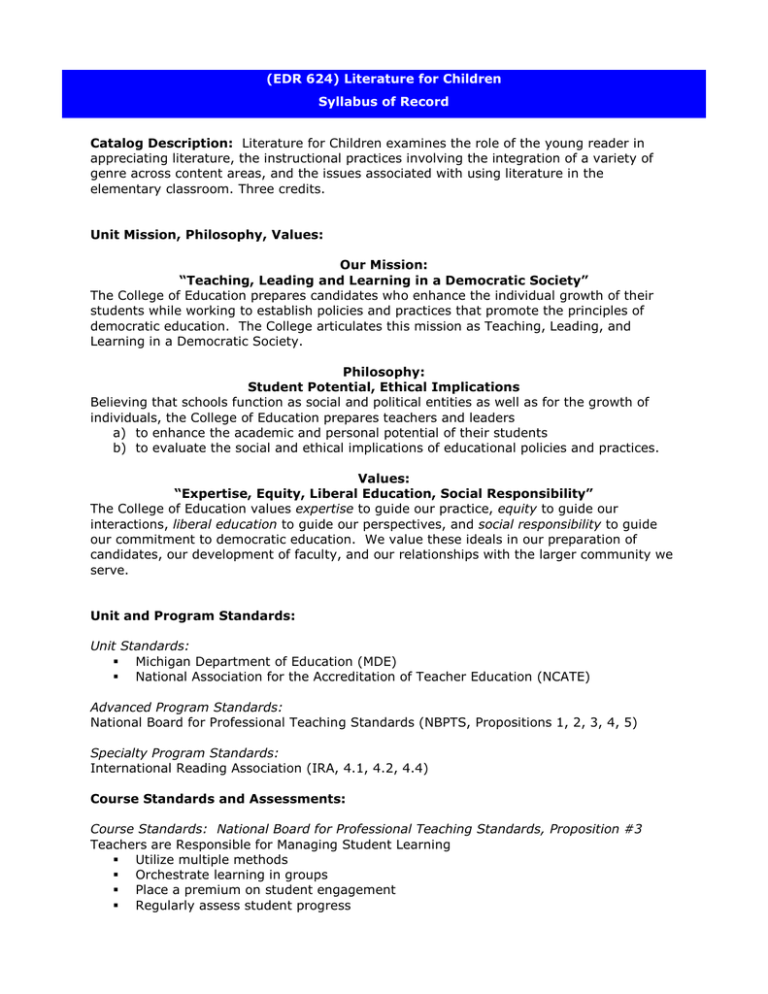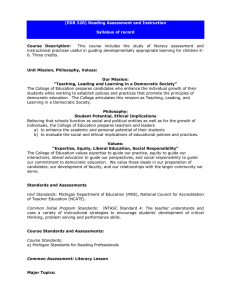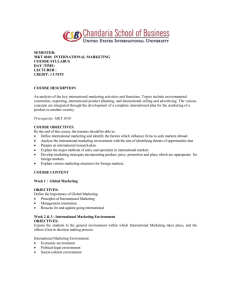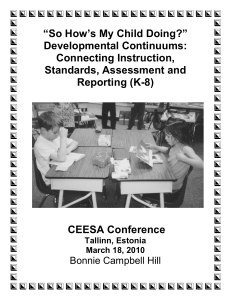(EDR 624) Literature for Children Syllabus of Record
advertisement

(EDR 624) Literature for Children Syllabus of Record Catalog Description: Literature for Children examines the role of the young reader in appreciating literature, the instructional practices involving the integration of a variety of genre across content areas, and the issues associated with using literature in the elementary classroom. Three credits. Unit Mission, Philosophy, Values: Our Mission: “Teaching, Leading and Learning in a Democratic Society” The College of Education prepares candidates who enhance the individual growth of their students while working to establish policies and practices that promote the principles of democratic education. The College articulates this mission as Teaching, Leading, and Learning in a Democratic Society. Philosophy: Student Potential, Ethical Implications Believing that schools function as social and political entities as well as for the growth of individuals, the College of Education prepares teachers and leaders a) to enhance the academic and personal potential of their students b) to evaluate the social and ethical implications of educational policies and practices. Values: “Expertise, Equity, Liberal Education, Social Responsibility” The College of Education values expertise to guide our practice, equity to guide our interactions, liberal education to guide our perspectives, and social responsibility to guide our commitment to democratic education. We value these ideals in our preparation of candidates, our development of faculty, and our relationships with the larger community we serve. Unit and Program Standards: Unit Standards: Michigan Department of Education (MDE) National Association for the Accreditation of Teacher Education (NCATE) Advanced Program Standards: National Board for Professional Teaching Standards (NBPTS, Propositions 1, 2, 3, 4, 5) Specialty Program Standards: International Reading Association (IRA, 4.1, 4.2, 4.4) Course Standards and Assessments: Course Standards: National Board for Professional Teaching Standards, Proposition #3 Teachers are Responsible for Managing Student Learning Utilize multiple methods Orchestrate learning in groups Place a premium on student engagement Regularly assess student progress Focus on multiple objectives Common Course Assessment: Book Card File Major Topics: Trade books Engagement strategies Assessment Censorship issues Key authors and illustrators Responding to literature Additional Information: The class includes lecture, discussion, structured class activities and cooperative learning. Students are encouraged to use their creativity, knowledge and initiative in fulfilling course requirements. Students will find that what they take from this class will be directly connected to their enthusiasm for and engagement with the assignments and class activities. The course Blackboard site will also be used. As a courtesy to others, please turn off cell phones before class starts. Course Knowledge Base: Barton, J., (2001). Teaching with children’s literature. Christopher-Gordon Publishers, Inc., Norwood, MA. Cullinan, B. editor, (1992). Invitation to read: More children’s literature in the reading program. International Reading Association, Newark, DE. Darigan, D., Tunnell, M., & Jacobs, J., (2002). Children's literature: Engaging teachers and children in good books. Prentice Hall, Englewood Cliffs, NJ. Hancock, M., (2000). A celebration of literature and response: Children, books and teachers in K-12 classrooms. Prentice Hall, Upper Saddle River, NJ. Hill, B. C., Johnson, N. J., and Schlick Noe, K. L., (1995). Literature circles and response. Christopher-Gordon Publishers, Inc., Norwood, MA. Horning, K., (1997). From cover to cover: Evaluating and reviewing children’s books. HarperCollins Publishers, New York. Kohl, H., (1995). Should we burn Babar?: Essays on children’s literature and the power of stories. Heinemann, Portsmouth, NH. Jobe, R., & Dayton-Sakari, M., (1999). Reluctant readers: Connecting students and books for successful reading experiences Pembroke Publishers, Markham, Ontario, Canada Norton, D. E., (2002). Through the eyes of a child: An introduction to children's literature. 6th ed., Prentice-Hall/Merrill Education, Englewood Cliffs, NJ. _____, (2001). Multicultural children’s literature: Through the eyes of many children. 1st ed., Prentice-Hall/Merrill Education, Englewood Cliffs, NJ. Routman, R., (1999). Conversations: Strategies for teaching, learning and evaluation. Heinemann Educational Books, Inc., Portsmouth, NH. Schlick Noe, K. L. and Johnson, N. J., (1999). Getting started with literature circles. Christopher-Gordon Publishers, Inc., Norwood, MA. Tunnel, M. and Jacobs, J., (2000). Children's literature briefly. 2nd ed., Prentice-Hall, Inc., Upper Saddle River, NJ.





